Hokkaido Heritage
Hokkaidō Heritage (
| Asset | Municipality | Comments | Image | Coordinates | Session | Ref |
|---|---|---|---|---|---|---|
| North Breakwater Dome in Wakkanai Port Wakkanai-kō kita-bōhatei dōmu |
Wakkanai | Built in connection with the former Chihaku ferry that connected Wakkanai with Ōdomari, now Korsakov, in what was then Karafuto Prefecture, South Sakhalin |  |
45°25′13″N 141°40′50″E / 45.420255°N 141.680492°E | I | [1] |
| Circumferential Glacier Topography of Sōya Hills Sōya kyūryō no shūhyōga chikei |
Wakkanai | Formed around 20,000 years ago during the Last Glacial Period; site of Sōya Misaki Wind Farm | 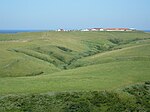 |
45°28′55″N 141°55′07″E / 45.481875°N 141.918716°E | II | [2] |
| The Teshio River Teshio-gawa |
Bifuka, Horonobe, Kenbuchi, Nakagawa, Nayoro, Otoineppu, Shibetsu, Shimokawa, Teshio, Toyotomi, Wakkanai, Wassamu | At 256 kilometres (159 mi), the second longest river on the island (after the Ishikari River) | 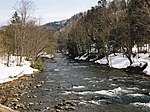 |
44°52′44″N 141°44′18″E / 44.878889°N 141.738333°E | II | [3] |
| The Herring Highway in Rumoi Rumoi no nishin kaidō |
Rumoi, Obira, Tomamae | Includes the Former Saga Fishing Ground ( |
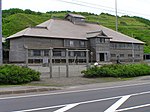 |
44°08′11″N 141°39′19″E / 44.136436°N 141.655248°E | I | [4] |
| Historical Buildings in Mashike Mashike no rekishi-teki tatemono-gun |
Mashike | Includes the Former Honma Family Residence ( |
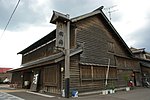 |
43°51′11″N 141°31′35″E / 43.853019°N 141.526378°E | I | [5] |
| Asahibashi Bridge Asahi-bashi |
Asahikawa | Over the Ishikari River; completed in 1932 to replace the 1892 bridge of wood covered in earth | 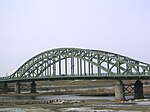 |
43°46′44″N 142°21′36″E / 43.778803°N 142.360015°E | II | [6] |
| Museum of Soils "Mansion of Soils" Tsuchi no Hakubutsukan "Tsuchi no Yakata" |
Kamifurano | Tells the story of the agricultural development of the island from the time of the Hokkaidō Development Commission, also of the 1926 eruption of Mount Tokachi | 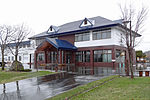 |
43°27′46″N 142°27′07″E / 43.462673°N 142.451814°E | II | [7] |
| Uryū Marsh Uryū-numa shitsugen |
Uryū | In Shokanbetsu-Teuri-Yagishiri Quasi-National Park; a Ramsar Site |  |
43°27′46″N 142°27′07″E / 43.462673°N 142.451814°E | II | [8] |
| Hokkai Principal Irrigation Channel Hokkai kansen-yō suiro |
Akabira, Bibai, Iwamizawa, Mikasa, Naie, Nanporo, Sunagawa | The longest exclusively agricultural irrigation channel in the country; runs 80 kilometres (50 mi) from Akabira to Nanporo; constructed in four years from 1924; draws water from the Sorachi River ( |
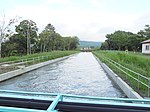 |
43°18′15″N 141°50′59″E / 43.304085°N 141.849781°E | II | [9] |
| Colliery-related Facilities, and Life and Culture of Sorachi Sorachi no tankō kanren shisetsu to seikatsu bunka |
Ashibetsu, Bibai, Iwamizawa, Utashinai, Yūbari, etc | At the industry's peak in the 1960s there were some 110 mines in Sorachi, with an annual output of 17,500,000 metric tons (17,200,000 long tons; 19,300,000 short tons); all had closed by the 1990s; see Ishikari coalfield, Hokutan Horonai coal mine, Yūbari Coal Mine Museum |  |
43°04′06″N 141°59′21″E / 43.068387°N 141.989132°E | I | [10] |
| The Ishikari River Ishikari-gawa |
Ishikari, etc | The longest on the island and third longest in the country, the river flows from the Daisetsuzan Mountains into the Sea of Japan | 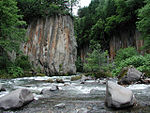 |
43°16′07″N 141°22′18″E / 43.268678°N 141.371690°E | I | [11] |
| Bricks of Ebetsu Ebetsu no renga |
Ebetsu | Construction in brick was encouraged by the Hokkaidō Development Commission, resulting in buildings such as the Former Hokkaidō Government Office in Sapporo; at one point there were seventeen brickworks in eight areas of the prefecture, but during the Taishō era they converged on Ebetsu, with its fine clays; three brickworks continue in the area today; there are some four hundred brick buildings in the city, including the Former Hida Factory ( |
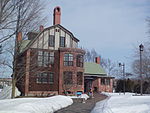 |
43°05′47″N 141°31′21″E / 43.096320°N 141.522504°E | II | [12] |
| Hokkaido University, the Sapporo Agricultural College Farm No.2 Hokkaidō Daigaku Sapporo Nō Gakkō dai-ni nōjō |
Sapporo | Founded in 1877 by William S. Clark as a "model" farm | 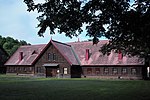 |
43°04′56″N 141°20′25″E / 43.082100°N 141.340311°E | I | [13] |
| The European Architecture in the Era of the Hokkaidō Development Commission Kaitakushi jidai no yōfū kenchiku |
Sapporo | Includes the Sapporo Clock Tower, Hōheikan (pictured), Seikatei, Former Nagayama Residence ( |
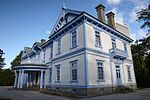 |
43°03′45″N 141°21′13″E / 43.062570°N 141.353607°E | II | [14] |
| The Factories and Memorial Halls in Naebo, Sapporo Sapporo Naebo chiku no kōjō kinenkan-gun |
Sapporo | Includes the Hokkaidō Railway Technology Museum ( |
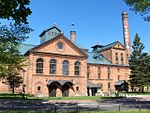 |
43°04′17″N 141°22′08″E / 43.071444°N 141.368934°E | II | [15] |
| Otaru Minato Harbour and Breakwater Otaru minato to bōhatei |
Otaru | The north breakwater was designed by Hiroi Isami ( |
 |
43°11′18″N 141°01′52″E / 43.188311°N 141.031239°E | I | [16] |
| Nikka Whisky Yoichi Distillery ニッカウヰスキー Nikka Uwisukii Yoichi jōryū-sho |
Yoichi | Taketsuru Masataka opened his distillery here in 1934, malt whisky production starting two years later | 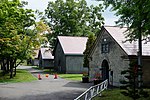 |
43°11′08″N 140°47′21″E / 43.185419°N 140.789238°E | II | [17] |
| The Shakotan Peninsula and Cape Kamui Shakotan-hantō to Kamui-misaki |
Shakotan etc | Remains of the old herring industry, which prospered from the Meiji period to the Shōwa era include a banya ( |
 |
43°20′01″N 140°20′47″E / 43.333490°N 140.346340°E | II | [18] |
| Natural Spring Water in Kyōgoku Kyōgoku no fukidashi yūsui |
Kyōgoku | One of the largest springs in the country, replenished by snow thaw from Mount Yōtei that filters through minerals underground; selected in 1985 by the Environmental Agency as one of the 100 Select Waters ( |
 |
42°51′29″N 140°52′08″E / 42.857961°N 140.868886°E | I | [19] |
| Skiing and the Niseko Mountains スキーとニセコ Sukii to Niseko renpō |
Kutchan, Niseko | Skiing grew in popularity both locally and across the country at large in the 1960s |  |
42°51′42″N 140°41′53″E / 42.861634°N 140.698100°E | II | [20] |
| Beech Forests at the Northern Boundary Hokugen no buna bayashi |
Kuromatsunai | The Oshima Peninsula marks the northern limit of this temperate zone tree; in Nanae there is a beech forest planted by Reinhold Gaertner (ガルトネル), son of painter Eduard and brother of Hakodate Consul Conrad | 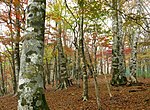 |
42°39′35″N 140°19′10″E / 42.659663°N 140.319471°E | II | [21] |
| Shōwashinzan International Snowball Fight Festival Shōwa-shinzan Kokusai Yukigassen Taikai |
Sōbetsu | Shōwa-shinzan or "new mountain of the Shōwa era" was formed by volcanic lava in the 1940s; this competitive snowballing or yuki-gassen began in 1989 |  |
42°32′27″N 140°51′27″E / 42.540770°N 140.857590°E | I | [22] |
| Noboribetsu Onsen Jigoku-dani Noboribetsu onsen Jigoku-dani |
Noboribetsu | There are fifteen so-called thermal "hells" in the valley, which is surrounded by Ōyu Pond ( |
 |
42°29′51″N 141°08′55″E / 42.497623°N 141.148682°E | II | [23] |
| The Remains of Jōmon Culture on the Coast of Uchiura Gulf Uchiura-wan engan no Jōmon bunka iseki-gun |
Date, Hakodate, etc | Four million artefacts, including "Hollow Dogū", have been found at eighty-nine sites in Hakodate alone; see Ōfune Site|, Kitakogane Shell Mound ( |
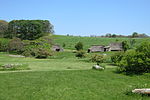 |
42°24′04″N 140°54′40″E / 42.401241°N 140.911023°E | I | [24] |
| The Ubagami Daijingū Festival Ubagami Daijingū togyo-sai |
Esashi | Herring-related matsuri, some 360 years old | 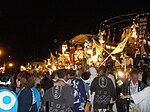 |
41°51′59″N 140°07′30″E / 41.866431°N 140.125050°E | I | [25] |
| Esashi Oiwake Esashi oiwake |
Esashi | folk song |  |
41°52′07″N 140°07′36″E / 41.868705°N 140.126609°E | II | [26] |
| The Former Fort from the 15th Century in Kaminokuni Kaminokuni no chūsei no tate |
Kaminokuni | Katsuyama-date ( |
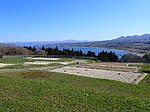 |
41°48′05″N 140°06′03″E / 41.801487°N 140.100798°E | I | [27] |
| Fukuyama (Matsumae) Castle and its Temple District Fukuyama (Matsumae)-jō to teramachi |
Matsumae | The last castle to be built in Edo period Japan; it served as the base for the Matsumae Domain daimyō and later as a battleground during the Boshin War and Battle of Hakodate; to the north of the castle is a temple district with five temples, Hōdō-ji ( |
 |
41°25′48″N 140°06′30″E / 41.429903°N 140.108466°E | I | [28] |
| Goryōkaku and the Relics of the Battle of Hakodate Goryōkaku to Hakodate sensō no ikō |
Hakodate etc | Includes Goryōkaku, Shiryōkaku, Fukuyama Castle, the waters off Kamome Island where the Japanese frigate Kaiyō Maru sank, Washinoki, where the shogunate forces under Enomoto Takeaki landed, the battlefield of Futamataguchi ( |
 |
41°47′49″N 140°45′24″E / 41.796937°N 140.756765°E | II | [29] |
| Mount Hakodate and the Remains of the Batteries Hakodate-yama to hōdai ato |
Hakodate | Famous as the location for one of the Three Night Views of Japan; fortified from the mid-Meiji period |  |
41°45′24″N 140°42′06″E / 41.756579°N 140.701690°E | I | [30] |
| Seibuchiku Area in Hakodate Hakodate Seibu-chiku no machi-nami |
Hakodate | The Port of Hakodate was a treaty port that opened to foreign ships in Ansei 6 (1859); includes the red brick warehouses, Former Public Hall of Hakodate Ward ( |
 |
41°45′46″N 140°42′44″E / 41.762817°N 140.712187°E | II | [31] |
| The Tramways Romen densha |
Hakodate, Sapporo | Hakodate City Tram (pictured) first operated as a horse-drawn railway car in 1897 and was electrified in 1913; the Sapporo Streetcar began operations in 1918 | 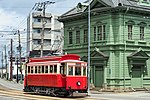 |
41°46′20″N 140°43′40″E / 41.772280°N 140.727866°E | I | [32] |
| The Cherry Trees on Nijikken Road in Shizunai Shizunai Nijikken-dōro no sakura namiki |
Shinhidaka | With the Hidaka Mountains as backdrop, some three thousand cherry trees, including 90-year old Ezoyama cherries, line a 7 kilometres (4.3 mi) stretch of the Nijikken Road that runs between Shizunai and Niikappu, to the pastures opened in line with Kuroda Kiyotaka's advice for the rearing of larger horses from the native breeds |  |
42°23′49″N 142°26′28″E / 42.396827°N 142.441200°E | II | [33] |
| Mōru Hot Springs モール Mōru onsen |
Otofuke | The name is derived from the German Moor, the springs rising through peat; includes Tokachigawa Onsen ( |
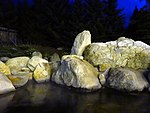 |
42°55′56″N 143°17′48″E / 42.932222°N 143.296753°E | II | [34] |
| Rawan Butterburs ラワンブキ Rawan-buki |
Ashoro | Giant butterburs that grow to a height of 2 metres (6.6 ft) to 3 metres (9.8 ft) along the Rawan River ( |
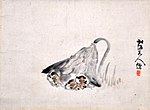 |
43°20′16″N 143°50′44″E / 43.337831°N 143.845420°E | I | [35] |
| The Former National Railroad and Concrete Arch Bridges of the Shihoro Line kyū-Kokutetsu Shihoro-sen konkurīto āchi kyōryō-gun |
Kamishihoro | Thirty-four bridges from the early Shōwa era are preserved, including Taushubetsu Bridge ( |
 |
43°24′56″N 143°11′20″E / 43.415422°N 143.188858°E | I | [36] |
| Kiritappu Wetland Kiritappu shitsugen |
Hamanaka | A Ramsar Site and Wildlife Protection Area; in Akkeshi Prefectural Natural Park; its "peat-forming plant communities" are a Natural Monument | 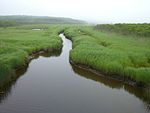 |
43°05′04″N 145°04′48″E / 43.084421°N 145.079954°E | I | [37] |
| Lake Mashū Mashū-ko |
Teshikaga | An endorheic crater lake in Akan National Park said to be one of world's clearest lakes |  |
43°35′00″N 144°31′42″E / 43.583456°N 144.528330°E | I | [38] |
| The Konsen Highland Windbreak Konsen daichi no kōshi-jō bōfū-rin |
Betsukai, Nakashibetsu, Shibecha, Shibetsu | A grid formed by bands of trees some 180 metres (590 ft) wide that run a total of 648 kilometres (403 mi) | 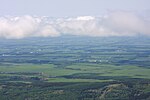 |
43°11′37″N 145°02′11″E / 43.193724°N 145.036324°E | I | [39] |
| The Notsuke Peninsula and the Utase Boats Notsuke-hantō to utase-bune |
Betsukai, Shibetsu | The biggest sandspit in Japan, extending 26 kilometres (16 mi); there are remains of Satsumon culture pit dwellings, while in the Edo period there was a checkpoint regulating travel and trade with Kunashir Island |  |
43°36′12″N 145°17′32″E / 43.603198°N 145.292253°E | II | [40] |
| Wakka/Koshimizu primaeval flower garden ワッカ/ Wakka/Koshimizu gensei ka-en |
Kitami, Koshimizu | Facing the Sea of Okhotsk and Lake Saroma, the Wakka Primaeval Flower Garden is the longest stretch of undeveloped and uncultivated land on the coastline of Japan and has some three hundred different flowers; see Lake Tōfutsu |  |
44°08′08″N 143°57′39″E / 44.135480°N 143.960801°E | I | [41] |
| The Pierson Memorial House ピアソン Piason Kinenkan |
Kitami | Built in 1914 as the home for American missionaries George and Ida Pierson by architect Merrell Vories Hitotsuyanagi |  |
43°48′24″N 143°53′13″E / 43.806536°N 143.886909°E | I | [42] |
| The Forest Railroad Steam Locomotive "Amamiya No.21" Shinrin Tetsudō jōki kikansha "Amamiya 21-gō" |
Engaru | See Hokkaido Maruseppu Recreation Forest Park Railway | 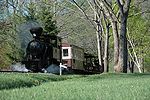 |
43°55′55″N 143°20′12″E / 43.931858°N 143.336762°E | II | [43] |
| Ancient Remains along the Okhotsk Coast オホーツク Ohōtsuku engan no kodai iseki-gun |
Abashiri, Engaru, Kitami, Shari, etc | Deposits from the Paleolithic, Jōmon and Zoku-Jōmon periods, Okhotsk culture and Ainu; includes the Shirataki Site ( |
 |
44°01′30″N 144°16′05″E / 44.024977°N 144.268069°E | II | [44] |
| Ice Floes and Garinko Ryūhyō to Garinko-gō |
Monbetsu | '"Drift Ice in the Sea of Okhotsk" is one of the 100 Soundscapes of Japan; Garinko (pictured) is an icebreaker |  |
44°20′01″N 143°22′23″E / 44.333631°N 143.372962°E | II | [45] |
| Villages of the Farmer-Soldiers and Military Barracks Tondenhei mura to heioku |
Akkeshi, Ebetsu, Nemuro, Sapporo, Shibetsu, etc | See Tondenhei | 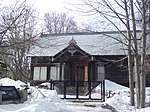 |
43°04′35″N 141°18′07″E / 43.076262°N 141.301893°E | II | [46] |
| Hokkaidō Horse Culture Hokkaidō no uma bunka |
Obihiro, etc | See Ban'ei, Dosanko |  |
42°55′16″N 143°10′56″E / 42.921065°N 143.182194°E | II | [47] |
| Ainu Place Names アイヌ Ainu-go chimei |
passim | Some 80% of Hokkaidō's Place Names are said to be derived from the Ainu language | 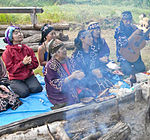 |
42°38′07″N 142°09′41″E / 42.635226°N 142.161387°E | I | [48] |
| Ainu Patterns アイヌ Ainu monyō |
passim | The three fundamental Ainu designs are the spiral (モレウ, moreu), thorn pattern (アイウシ, aiushi), and fish scale pattern (ラムラムノカ, ramramnoka), that are then endlessly reimagined and recombined |  |
42°38′13″N 142°09′25″E / 42.636891°N 142.156936°E | I | [49] |
| Ainu Oral Culture アイヌ Ainu kōshō bungei |
passim | See Yukar, Kutune Shirka, Imekanu, Chiri Yukie (pictured) |  |
42°33′41″N 141°22′01″E / 42.561347°N 141.366885°E | II | [50] |
| The Culture of Salmon サケの Sake no bunka |
passim | See Japan Heritage "story" #084, Shibetsu Salmon Science Museum | 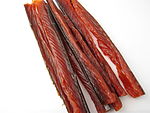 |
43°39′36″N 145°06′59″E / 43.659962°N 145.116335°E | II | [51] |
| Hokkaidō Ramen Noodles Hokkaidō no rāmen |
Asahikawa, Hakodate, Kushiro, Sapporo, etc | See Regional variations of ramen, Muroran curry ramen | 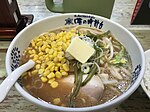 |
43°03′20″N 141°21′12″E / 43.055457°N 141.353246°E | I | [52] |
| Genghis Khan ジンギスカン Jingisukan |
passim | Involves a distinctively-shaped cooking pan (pictured) | 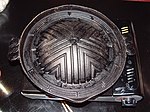 |
43°03′20″N 141°21′12″E / 43.055457°N 141.353246°E | II | [53] |
| Rishiri Island Fishing Industry Heritage Sites and Life and Culture Rishiritō no gyogyō isan-gun to seikatsu bunka |
Rishiri, Rishirifuji | The key products of Rishiri Island (pictured) included herring, kombu, abalone, and sea cucumbers; in the Edo period there was a trading station for traders from Matsumae Domain and the Ōmi merchants ( |
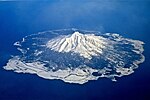 |
45°06′47″N 141°12′58″E / 45.112995°N 141.216160°E | III | [54] |
| Asahikawa Furniture Asahikawa kagu |
Asahikawa | Includes the Oda Collection, "connecting wooden furniture culture with the world" ( |
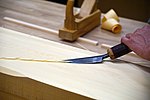 |
43°48′00″N 142°24′56″E / 43.800090°N 142.415599°E | III | [55] |
| Miura Ayako Literature Museum and Foreign Species Specimen Forest Miura Ayako Kinen Bungakukan to Gaikoku Jushu Mihon-rin |
Asahikawa |  |
43°45′13″N 142°20′53″E / 43.753600°N 142.348021°E | III | [56] | |
| Mashike Mountain Trail and Gokibiru Mountain Trail Mahike-sandō to Gokibiru-sandō |
Ishikari, Mashike | 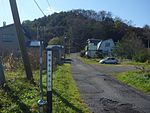 |
43°50′07″N 141°29′16″E / 43.835199°N 141.487810°E | III | [57] | |
| Hokkaidō Shūchikan Prisons Hokkaidō no shūchikan |
Abashiri, Mikasa, Obihiro, Shibecha, Tsukigata | Five penitentiaries built between 1881 and 1893 to house political prisoners from the Satsuma Rebellion, and later for those convicted of serious crimes; see Abashiri Prison Museum (pictured) | 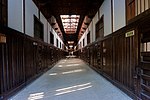 |
43°59′46″N 144°13′43″E / 43.996019°N 144.228724°E | III | [58] |
| Otaru Railway Heritage Otaru no tetsudō isan |
Otaru | See Otaru Station, Otaru City General Museum, Former Temiya Line | 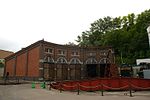 |
43°12′40″N 141°00′03″E / 43.211218°N 141.000728°E | III | [59] |
| Achievements of Ōtomo Kametarō and Remains of Ōtomo-bori Ōtomo Kametarō no jiseki to Ōtomo-bori ikō |
Sapporo | 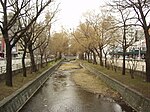 |
43°05′58″N 141°20′44″E / 43.099342°N 141.345455°E | III | [60] | |
| Pacific Music Festival パシフィック・ミュージック・フェスティバル Pashifikku myūjikku fesutibaru |
Sapporo | Founded by Leonard Bernstein in 1990 |  |
42°56′20″N 141°20′24″E / 42.939007°N 141.340087°E | III | [61] |
| Sapporo Soft Stone Sapporo nanseki |
Sapporo |  |
42°58′09″N 141°20′29″E / 42.969074°N 141.341516°E | III | [62] | |
| Three Government Temples of Ezo Ezo Sankanji |
Akkeshi, Date, Samani | Kokutai-ji ( |
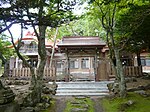 |
43°01′56″N 144°50′18″E / 43.032092°N 144.838392°E | III | [63] |
| Shikabe Geyser しかべ Shikabe kanketsusen |
Shikabe | 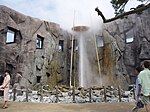 |
42°01′43″N 140°49′50″E / 42.028701°N 140.830488°E | III | [64] | |
| Mukawa Town Hobetsu Fossils of Sentient Beings of Old むかわ Mukawa-chō Hobetsu no koseibutsu kaseki-gun |
Mukawa |  |
42°45′58″N 142°08′09″E / 42.766101°N 142.135716°E | III | [65] | |
| Hokkaidō Basic Railroads Hokkaidō no kan'i kidō |
Tsurui, etc |  |
43°13′43″N 144°19′33″E / 43.228654°N 144.325727°E | III | [66] | |
| Chishimazakura Cherry Trees Chishima-zakura |
passim | 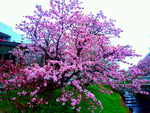 |
43°19′43″N 145°34′32″E / 43.328492°N 145.575617°E | III | [67] | |
| Traces of the Exploration of Ezo by Matsuura Takeshirō Matsuura Takeshirō ni yoru Ezo-chi tōsa no ashiato |
passim |  |
43°03′12″N 141°29′48″E / 43.053221°N 141.496772°E | III | [68] | |
| Shimokawa Circular Forest Culture しもかわの Shimokawa no junkan-gata shinrin bunka |
Shimokawa | hōseirin ( |
44°18′02″N 142°38′35″E / 44.3004679°N 142.643053°E | IV | [69] | |
| The Roots of Hokkaidō Rice, Akage-mai Hokkaidō kome no rūtsu「akage-mai」 |
Kitahiroshima | in 1873, Nakayama Kyūzō ( |
42°55′24″N 141°32′15″E / 42.923418°N 141.537399°E | IV | [70] | |
| Imakane and Pirika Gold Mine Sites Imakane・Pirika no kinzan iseki |
Imakane | 42°28′14″N 140°11′27″E / 42.470543°N 140.190780°E | IV | [71] | ||
| Sendai Domain Shiraoi Moto-Jin'ya Sendai-han Shiraoi moto-jin'ya |
Shiraoi | jin'ya |  |
42°33′51″N 141°20′36″E / 42.564098°N 141.343226°E | IV | [72] |
| Sea of Trees at Tokachi-Mitsumata Tokachi Mitsumata no jukai |
Kamishihoro |  |
43°31′00″N 143°09′00″E / 43.516667°N 143.150000°E | IV | [73] | |
| Shimo-no-ku Karuta shimo-no-ku karuta |
passim | variant of uta-garuta |  |
IV | [74] |
See also
[edit]- Cultural Properties of Japan
- Japan Heritage
- List of Historic Sites of Japan (Hokkaidō)
- List of Cultural Properties of Japan - structures (Hokkaidō)
- List of Natural Monuments of Japan (Hokkaidō)
References
[edit]- ^
北海道 遺産 のご紹介 [Introduction to Hokkaidō Heritage] (in Japanese). Hokkaido Heritage Council. Retrieved 1 August 2024. - ^
北海道 遺産 とは [Hokkaido Heritage] (in Japanese). Hokkaido Heritage Council. Retrieved 24 September 2019. - ^
次世代 に遺 したい北海道 の宝物 -北海道 遺産 [Treasures of Hokkaido to be passed to the Next Generation] (in Japanese). Hokkaido Prefecture. Retrieved 24 September 2019. - ^ Babb, James D, ed. (2015). The SAGE Handbook of Modern Japanese Studies. SAGE Publishing. p. 94. ISBN 978-1848606630.
External links
[edit]- (in Japanese) List (Hokkaidō Government)
- (in Japanese) List (Hokkaidō Heritage Council)
